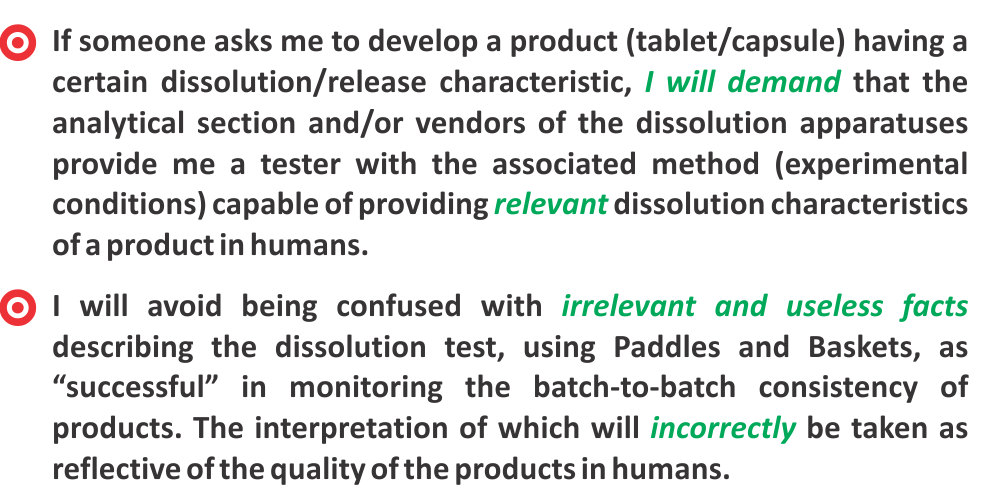Monthly Archives: January 2012
F2 – Similarity Factor (A Deficiency)
The similarity Factor or F2 is a parameter commonly used to show similarity or equivalence of two dissolution profiles. The F2-value is often calculated using the formula described here (link). The values of F2 range from 0 to 100. Commonly, a value between 50 and 100 is considered to reflect the similarity of two dissolution profiles which implies that the products will have similar in vivo drug release characteristics as well.(please click here for complete post).
Some Thoughts on a Recent US FDA Document “Quality by Design for ANDAs: An Example for Modified Release Dosage Forms”
The US FDA (CDER) released a document on the above mentioned title (Link). This single spaced 161-page long document provides an example of conducting and reporting studies for developing generic drug products as per the QbD (Quality by Design) approach.
It appears that this document may also be considered a “How-to manual on drug dissolution testing”, as a significant portion of the document describes the development and application of the dissolution testing.
It may be argued that if current practices of drug dissolution testing would not have faced so many problems/deficiencies and uncertainties, the procedures and documentations provided would certainly be simpler and shorter. Therefore, indirectly, the document may be considered as a long awaited recognition of the fact that current practices of drug dissolution testing are complicated and complex, and may not be working as well as one should expect.(please click here for complete post).
Can an Appropriate Dissolution Method Transfer Protocol be Developed?
In simple terms, a dissolution method transfer protocol (“protocol”) is a description of a mutual understanding of two parties, developer or current user of an analytical method (“originator”) and the receiver (“recipient”) of the method as to how a dissolution test is to be conducted.
There are numerous situations where such protocols are needed, for example, transferring a method from R&D to the QC section, one plant to another plant, manufacturer to contract organization (CRO) or to sub contractor etc. The easiest and most practical approach for developing the protocol appears to be that both parties work together to develop step by step instructions which are able to be followed by current or future analysts to conduct the test as expected to produce consistent results.
The understanding between the two parties reflects how a test is to be conducted and what kind of output should be expected. The protocol can be: (1) simple/verbal understanding between parties such as preparation of a 0.05M phosphate buffer having pH 5.8 as per USP or; (2) detailed and documented (written) step by step set of instructions for conducting the analytical test, e.g., dissolution. In both cases, the common aspect is that the method should be able to provide output which can be compared, for example; the final pH of the buffer solution, or dissolution results. For the comparison of results between two parties most often two sets of values are used which are the mean and standard deviation (STD) describing the characteristics of the test product. Continue reading
Potentially Incorrect Interpretation of In Vitro Dissolution Characteristics of Products – Glimepiride
Often I have written about the deficiencies (flaws) of the Paddle and Basket apparatuses in obtaining relevant and useful dissolution results. The underlying cause of these deficiencies is a poor stirring and mixing environment within dissolution vessels. However, as a long held tradition, these apparatuses are recommended and used for dissolution testing. As the apparatuses do not provide a relevant in vivo environment, obviously in vitro results would not be relevant to in vivo characteristics of drugs and their products. However, to maintain the status quo, the dissolution results obtained are rationalized as legitimate and useful. Considering practice of rationalization of dissolution results and noticing numerous queries in this regard about a drug glimepiride, I came across a publication (link) which may help in explaining the current dilemma of an analyst in dealing with in vitro drug dissolution testing. (please click here for complete post).
Physiological Considerations for Drug Dissolution Testing
Two Useful Resolutions for New Year – 2012
Critical Importance of Stirring/Mixing (churning) in Dissolution Testing
While surfing the Internet, I found two very interesting and useful video clips showing the digestion process in the human gastrointestinal tract. Click on the links to watch the videos (video1 and video2).
After watching these videos, it is very difficult to imagine that people would like to use the currently suggested dissolution apparatuses, in particular paddle and basket. Appropriate dissolution testing would require a fairly rigorous stirring and mixing process, as can be seen in the videos. Currently used apparatuses do not provide any mixing and stirring, in particular the paddle and basket.
An even more irrational and unscientific aspect is that people tend to emphasize the requirement, that the dissolution testing should be conducted using a disturbance free environment. Such requirements are reflected by the suggestions that apparatuses must be free from all forms of (almost nonexistent) vibrations and their effects. Furthermore, if a product moves, or floats, or is expected to move or float, within a dissolution vessel then often it is recommended that it must be caged in a so called a sinker to stop this floating and moving aspect. In addition, it is often recommended that a dissolution test at present should preferably be conducted using a de-aerated medium. It is not clear how this de-aeration step got incorporated in the dissolution testing when it is not relevant to the physiological environment.
From the videos and the comments above, it is clear that the currently used apparatuses provide an incorrect environment for dissolution testing. Furthermore, the suggested experimental conditions, such as de-aeration, vibration free environment and the use of a sinker or fixing product’s position are irrelevant. The data obtained using these apparatuses and the recommended experimental conditions would be of limited or no use.

